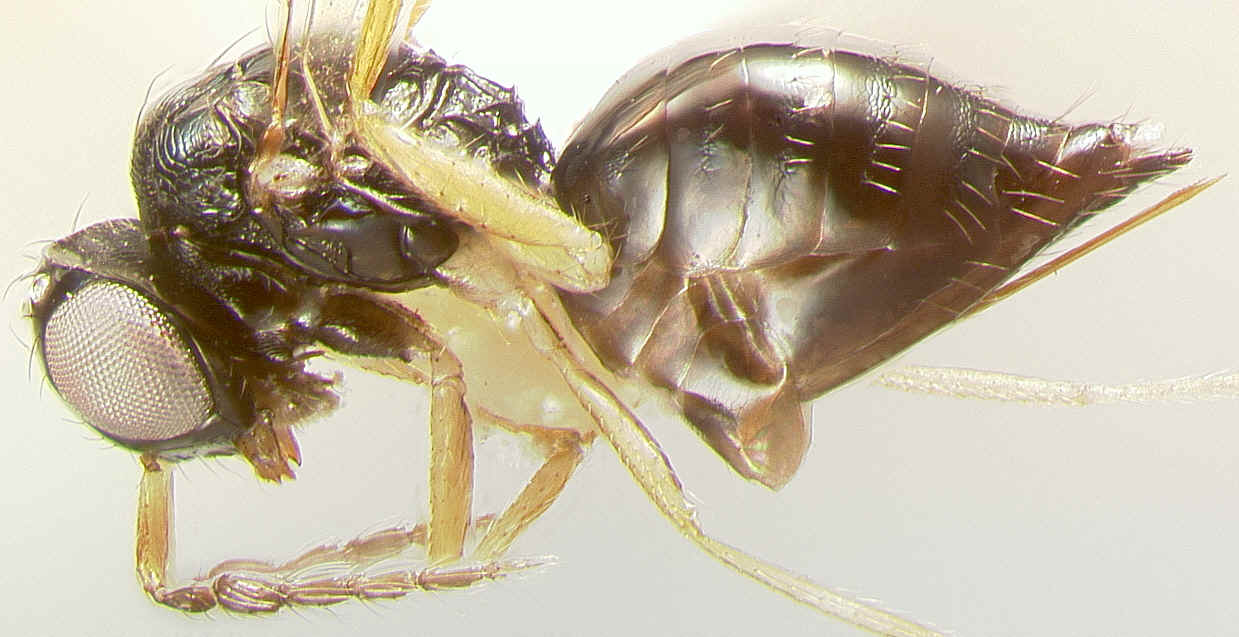1a-b: Holcopelte mesosoma (left), and face (right)
return to: Eul 1 Eul 4 eud 1 eul 1 ent 1 ent 5 ent 10 ent 13 ent 16 ent 21 ent 26
Holcopelte
Förster, 1856 comparative info return to: prev home
Mandibular formula 4:4. Face, frons,
and occiput completely smooth and glossy. Clypeus set off by distinct
sutures, transverse ridge separating toruli from clypeus. Transverse frontal
groove v-shaped; scrobal depressions uniting at or below transverse groove; interscrobal
process sharply raised above surrounding area. Flagellar formula 2,4,1; funicular
segments in males each with a basal whorl of long setae; flagellum with spear-shaped (type
3) peg sensilla. Median furrow extending from posterior part of mesoscutum to
anterior part of scutellum (rarely faint: H. huggerti Hansson); notauli
deep posteriorly but absent or very shallow anteriorly. Postmarginal vein shorter
than stigmal vein. Petiole distinct, subquadrate. Compare with: Omphale, Chrysocharis.
1a-b: Holcopelte mesosoma (left), and face (right)

Holcopelte
Biology: Parasitoids of gall-forming Cecidomyiids.
Comments: 9 described species. There are few Nearctic genera approaching Holcopelte morphologically, but some Oriental and Australasian genera, such as Parzaommomyia Girault, have the same characters that are otherwise so distinctive for Holcopelte. Parzaommomyia differs from Holcopelte in characters of purely continuous variation, such as the enlarged eyes and correspondingly tiny malar space, and in the elongate forewing.
Comparative information:
Omphale: Interscrobal process not raised above surrounding area. Never with furrow across mesoscutal-scutellar suture. Face sculptured in most species. Some species, especially in the Neotropical region, strongly resemble Holcopelte, especially in that the face is smooth and with a vaguely raised interscrobal process, and in the elongate (type 3) flagellar peg sensilla. These species have no sign of a longitudinal groove across the scutellar suture, but this is lacking or weakly defined in some species of Holcopelte as well, although when lacking it is usually replaced by a section of rough, narrowed and lengthened, sculpture, they also have shallow notauli. More study is needed to clarify the distinction between these two genera.
Chrysocharis: Interscrobal process not raised above surrounding area. Face never smooth and shiny. Almost never with furrow across mesoscutal-scutellar suture.
References
Hansson, C. 1988. New World species of Holcopelte and Ionympha (Hymenoptera: Eulophidae), with descriptions of two new species. Proceedings of the Entomological Society of Washington. 91: 59-65.
Image credits: 1a-b: Hansson (1988).